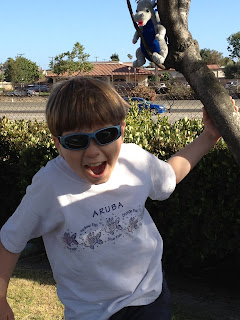Three years ago today our son Sam died. He was eight years old. Just 13 months prior to that he was diagnosed with a brain tumor out-of-the blue. He had been a bright-eyed, energetic, loving and highly intelligent little boy. After a brief but brutal fight he succumbed. Cancer took his precious life.
 Over the course of those 13 months we saw Sam develop a tremor in his hand that bothered him both physically and emotionally. We saw him gain nearly 50 pounds from steroids, lack of exercise and little else to do but eat. We suffered along with him as he told us about the ringing in his ear, which we couldn’t make go away. We stood close to him and held his hand as he began to lose his balance and co-ordination. We sat next to him and protected his shaking body through numerous difficult seizures, including one that lasted nearly 3 hours. We wheeled him places in his wheelchair when he lost the ability to walk. We saw him lose the ability to go to the bathroom by himself and eventually lose control of his bladder and other bodily functions. We looked on helplessly as he lost both his memory and extraordinary mental faculties. We leaned-in close to hear him as he whispered and struggled with words until he could no longer speak at all. Shortly thereafter he also lost the ability to eat and drink, save the drops of morphine we had to administer down his throat to ease the pain from the swelling in his brain. We surrounded him and held him as he took his last breaths of air on our couch under a full moon at 6:31 am on October 20, 2013.
Over the course of those 13 months we saw Sam develop a tremor in his hand that bothered him both physically and emotionally. We saw him gain nearly 50 pounds from steroids, lack of exercise and little else to do but eat. We suffered along with him as he told us about the ringing in his ear, which we couldn’t make go away. We stood close to him and held his hand as he began to lose his balance and co-ordination. We sat next to him and protected his shaking body through numerous difficult seizures, including one that lasted nearly 3 hours. We wheeled him places in his wheelchair when he lost the ability to walk. We saw him lose the ability to go to the bathroom by himself and eventually lose control of his bladder and other bodily functions. We looked on helplessly as he lost both his memory and extraordinary mental faculties. We leaned-in close to hear him as he whispered and struggled with words until he could no longer speak at all. Shortly thereafter he also lost the ability to eat and drink, save the drops of morphine we had to administer down his throat to ease the pain from the swelling in his brain. We surrounded him and held him as he took his last breaths of air on our couch under a full moon at 6:31 am on October 20, 2013.
That’s the short story of a kid who loses their battle with cancer. It isn’t pretty.
Sam had a bi-thalamic glioma, a type of brain tumor that, because of its location and the nature of the cancerous glial cells, could not be operated on. Inoperable brain tumors currently call for treatment either with chemotherapy or radiation or both. Neither treatment is desirable; each has its own horrible consequences and ill-effects. All of us have likely heard or seen the stories of other children—many right here in our own community—who have suffered the effects of both cancer as well as the potentially devastating effects of the cancer treatment itself.
Despite all this, perhaps because of this, Sabrina and I strive to remain positive. We have decided to harvest what could be loads of negative energy and channel it into a positive avenue—Sam’s Foundation. Sam’s Foundation is all about using the money we receive from donors to try to find cures, searching for and funding better treatment options for children with cancer, helping local families with financial needs and in general trying to raise awareness that childhood cancer is a serious problem and that we can do better as a society in the fight against it. These are things that will pay dividends years from now and hopefully pave the way for healthy lives for future generations.
With the help of some amazing Cal Poly students, who took it upon themselves to help us spread our message, and with some wonderful assistance from the Krasner-Green family who helped add the finishing touches, we’d like to share this video. Special thanks to Baylor Hunstad, Casey Li, Jessica Redmond, and Brian and Paul Green for their extraordinary efforts and talents.
As always we appreciate everything our supporters have done for us over the years. We are honored to have met so many wonderful people and have been lifted by all of the kind hearts.
John & Sabrina Jeffers www.samjeffersfoundation.org



















